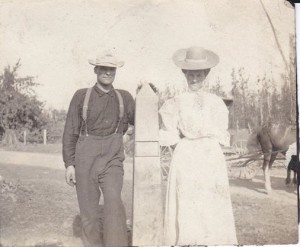 Here is a picture of Adele (Barkdul) and her second husband Clarence McBurney. Adele had the first white child born in Skagway, Beryl.
Here is a picture of Adele (Barkdul) and her second husband Clarence McBurney. Adele had the first white child born in Skagway, Beryl.
photo courtesy of Judith Bacon.

Stories and Folklore from Skagway, Alaska
Arthur O’Leary’s traveling companion, Ben Olcott has quite a story of his own, which I will summarize here.
Also born in Keithsburg, Illinois, Ben left earlier on his adventures west and in 1891 at the age of 19 moved to Salem, Oregon. He seemed to find Oregon his new home base from which he forayed to parts north to search for adventure and gold. After his 1898 trip with Arthur, he returned to Illinois to bank briefly and then headed back to Alaska in 1904. His journey ended notably when he drove a dog sled team to Nome, a trip of over 1,000 miles up theYukon and Tanna Rivers in the height of winter. Settling in Fairbanks, Olcott found work as a gold dust teller, and later a bank branch manager. He managed to make a sizeable profit from gold prospecting, allowing him to move back to Oregon.
Olcott became involved in Oregon politics because of his brother-in-law Oswald West and so found himself succeeding Governor Withycombe in 1919 who abruptly died of a heart attack only two months after being elected. Olcott served as governor until 1923 until he was defeated by the Ku Klux Klan candidate, Walter Pierce. Olcott went back to banking, first to Long Beach, California and then back to Portland. He died in Portland on July 21, 1952, and was interred in Mount Crest Abbey Mausoleum in Salem, Marion County, Oregon. He may have been pictured in the photos of Arthur O’Leary below, but here are his portrait and gravestone.
I recently received some original photos of Mr. O’Leary’s cabin and compadres on the trail. It is near Mirror Lake, which I don’t immediately have access to the exact location. I will post these here along with a photo of Mr. Arthur O’Leary in 1898 as he prepared to come to the Klondike. He was only 24 years old and full of the Irish heritage of adventure and hard work – don’t I know about that from my own family!
Anyway, here is his story as told by his great grand-daughter, Jeanie Decker:
Wortham was born on August 12, 1873 in Paris, Texas and was the manager of the Clifford Sifton steamer boat on Lake Bennett in 1900. He was a latecomer to the Yukon, arriving in 1900 but was still able to run a business on Lake Bennett then. The Clifford Sifton was built on Lake Bennett during the Gold Rush. Somehow it was later run on the Yukon River, how it got there must have been quite a feat!
Major James Matthew took the above photo of the Clifford Sifton running the Miles Canyon rapids around 1900. This was an extremely dangerous thing to do and only a daredevil would attempt it. The photo below shows it in 1902 on the Yukon River. That photo was taken by M.W. Goetzman.
Wortham died on this day, May 21, 1941 and is buried in Juneau at the Evergreen Cemetery.
Digby Courier June 1900 online; ancestry message board